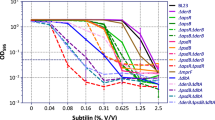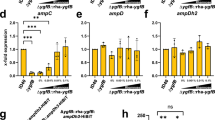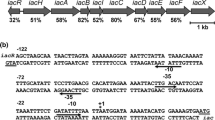Abstract
Antibiotic resistance genes are usually tightly controlled by transcription factors and RNA regulatory elements including sRNAs, riboswitches, and attenuators, and their expression is activated to respond to antibiotic exposure. In previous work, we revealed that the rppA gene is regulated by attenuator LRR and two mistranslation products in Bacillus thuringiensis BMB171. However, its function and promoter regulation is still not precise. In this study, we demonstrated that the encoding product of the rppA gene acts as an ARE1 ABC-F protein and confers resistance to antibiotics virginiamycin M1 and lincomycin when overexpressed. Besides the reported attenuator LRR, the expression of the rppA gene is controlled by the sigma factor SigA and a global transcription factor CcpA. Consequently, its promoter activity is mainly maintained at the stationary phase of cell growth and inhibited in the presence of glucose. Our study revealed the function and regulation of the rppA gene in detail.
Key points
• The RppA protein acts as an ARE1 ABC-F protein
• The rppA gene confers resistance to antibiotics virginiamycin M1 and lincomycin when overexpressed
• The expression of the rppA gene is regulated by the sigma factor SigA and the pleiotropic regulator CcpA







Similar content being viewed by others
Data availability
All the data generated or analyzed during this study are included in this published article (and its supplementary information files).
References
Blair JM, Webber MA, Baylay AJ, Ogbolu DO, Piddock LJ (2015) Molecular mechanisms of antibiotic resistance. Nat Rev Microbiol 13:42–51. https://doi.org/10.1038/nrmicro3380
Breaker RR (2018) Riboswitches and translation control. Cold Spring Harb Perspect Biol 10:a032797. https://doi.org/10.1101/cshperspect.a032797
Cai X, Zhan Y, Cao Z, Yan B, Cai J (2021a) Expression of ribosomal protection protein RppA is regulated by a ribosome-dependent ribo-regulator and two mistranslation products. Environ Microbiol 23:696–712. https://doi.org/10.1111/1462-2920.15143
Cai X, Wang Q, Fang Y, Yao D, Zhan Y, An B, Yan B, Cai J (2021b) Attenuator LRR - a regulatory tool for modulating gene expression in Gram-positive bacteria. Microb Biotechnol 14:2538–2551. https://doi.org/10.1111/1751-7915.13797
Crowe-McAuliffe C, Graf M, Huter P, Takada H, Abdelshahid M, Novacek J, Murina V, Atkinson GC, Hauryliuk V, Wilson DN (2018) Structural basis for antibiotic resistance mediated by the Bacillus subtilis ABCF ATPase VmlR. Proc Natl Acad Sci U S A 115:8978–8983. https://doi.org/10.1073/pnas.1808535115
Crowe-McAuliffe C, Murina V, Turnbull KJ, Kasari M, Mohamad M, Polte C, Takada H, Vaitkevicius K, Johansson J, Ignatova Z, Atkinson GC, O’Neill AJ, Hauryliuk V, Wilson DN (2021) Structural basis of ABCF-mediated resistance to pleuromutilin, lincosamide, and streptogramin A antibiotics in Gram-positive pathogens. Nat Commun 12:3577. https://doi.org/10.1038/s41467-021-23753-1
Crowe-McAuliffe C, Murina V, Turnbull KJ, Huch S, Kasari M, Takada H, Nersisyan L, Sundsfjord A, Hegstad K, Atkinson GC, Pelechano V, Wilson DN, Hauryliuk V (2022) Structural basis for PoxtA-mediated resistance to phenicol and oxazolidinone antibiotics. Nat Commun 13:1860. https://doi.org/10.1038/s41467-022-29274-9
Dar D, Sorek R (2017) Regulation of antibiotic-resistance by non-coding RNAs in bacteria. Curr Opin Microbiol 36:111–117. https://doi.org/10.1016/j.mib.2017.02.005
Dar D, Shamir M, Mellin JR, Koutero M, Stern-Ginossar N, Cossart P, Sorek R (2016) Term-seq reveals abundant ribo-regulation of antibiotics resistance in bacteria. Science 352:aad9822. https://doi.org/10.1126/science.aad9822
Delihas N, Forst S (2001) MicF: an antisense RNA gene involved in response of Escherichia coli to global stress factors. J Mol Biol 313:1–12. https://doi.org/10.1006/jmbi.2001.5029
Deng YJ, Wang SY (2016) Synergistic growth in bacteria depends on substrate complexity. J Microbiol 54:23–30. https://doi.org/10.1007/s12275-016-5461-9
Duval M, Dar D, Carvalho F, Rocha EPC, Sorek R, Cossart P (2018) HflXr, a homolog of a ribosome-splitting factor, mediates antibiotic resistance. Proc Natl Acad Sci U S A 115:13359–13364. https://doi.org/10.1073/pnas.1810555115
Ero R, Kumar V, Su W, Gao YG (2019) Ribosome protection by ABC-F proteins-molecular mechanism and potential drug design. Protein Sci 28:684–693. https://doi.org/10.1002/pro.3589
Evans CR, Fan Y, Weiss K, Ling J (2018) Errors during gene expression: single-cell heterogeneity, stress resistance, and microbe-host interactions. Mbio 9:e01018. https://doi.org/10.1128/mBio.01018-18
Felden B, Cattoir V (2018) Bacterial adaptation to antibiotics through regulatory RNAs. Antimicrob Agents Chemother 62:e02503-02517. https://doi.org/10.1128/AAC.02503-17
Fostier CR, Monlezun L, Ousalem F, Singh S, Hunt JF, Boël G (2021) ABC-F translation factors: from antibiotic resistance to immune response. FEBS Lett 595:675–706. https://doi.org/10.1002/1873-3468.13984
Gorke B, Stulke J (2008) Carbon catabolite repression in bacteria: many ways to make the most out of nutrients. Nat Rev Microbiol 6:613–624. https://doi.org/10.1038/nrmicro1932
Gruber TM, Gross CA (2003) Multiple sigma subunits and the partitioning of bacterial transcription space. Annu Rev Microbiol 57:441–466. https://doi.org/10.1146/annurev.micro.57.030502.090913
He J, Shao X, Zheng H, Li M, Wang J, Zhang Q, Li L, Liu Z, Sun M, Wang S, Yu Z (2010) Complete genome sequence of Bacillus thuringiensis mutant strain BMB171. J Bacteriol 192:4074–4075. https://doi.org/10.1128/JB.00562-10
He W, Zhang X, Zhang J, Jia X, Zhang J, Sun W, Jiang H, Chen D, Murchie AI (2013) Riboswitch control of induction of aminoglycoside resistance acetyl and adenyl-transferases. RNA Biol 10:1266–1273. https://doi.org/10.4161/rna.25757
Helmann JD, Chamberlin MJ (1988) Structure and function of bacterial sigma factors. Annu Rev Biochem 57:839–872. https://doi.org/10.1146/annurev.bi.57.070188.004203
Hibbing ME, Fuqua C, Parsek MR, Peterson SB (2010) Bacterial competition: surviving and thriving in the microbial jungle. Nat Rev Microbiol 8:15–25. https://doi.org/10.1038/nrmicro2259
Hinrichs W, Kisker C, Duvel M, Muller A, Tovar K, Hillen W, Saenger W (1994) Structure of the Tet repressor-tetracycline complex and regulation of antibiotic resistance. Science 264:418–420. https://doi.org/10.1126/science.8153629
Hong HJ, Hutchings MI, Buttner MJ (2008) Vancomycin resistance VanS/VanR two-component systems. Adv Exp Med Biol 631:200–213. https://doi.org/10.1007/978-0-387-78885-2_14
Horinouchi S, Weisblum B (1980) Posttranscriptional modification of mRNA conformation: mechanism that regulates erythromycin-induced resistance. Proc Natl Acad Sci U S A 77:7079–7083. https://doi.org/10.1073/pnas.77.12.7079
Ishihama A (2000) Functional modulation of Escherichia coli RNA polymerase. Annu Rev Microbiol 54:499–518. https://doi.org/10.1146/annurev.micro.54.1.499
Jia X, Zhang J, Sun W, He W, Jiang H, Chen D, Murchie AI (2013) Riboswitch control of aminoglycoside antibiotic resistance. Cell 152:68–81. https://doi.org/10.1016/j.cell.2012.12.019
Jiang K, Hou XY, Tan TT, Cao ZL, Mei SQ, Yan B, Chang J, Han L, Zhao D, Cai J (2018) Scavenger receptor-C acts as a receptor for Bacillus thuringiensis vegetative insecticidal protein Vip3Aa and mediates the internalization of Vip3Aa via endocytosis. PLoS Pathog 14:e1007347. https://doi.org/10.1371/journal.ppat.1007347
Jiang Q, Lou Z, Wang H, Chen C (2019) Antimicrobial effect and proposed action mechanism of cordycepin against Escherichia coli and Bacillus subtilis. J Microbiol 57:288–297. https://doi.org/10.1007/s12275-019-8113-z
Lenart J, Vimberg V, Vesela L, Janata J, Balikova Novotna G (2015) Detailed mutational analysis of Vga(A) interdomain linker: implication for antibiotic resistance specificity and mechanism. Antimicrob Agents Chemother 59:1360–1364. https://doi.org/10.1128/AAC.04468-14
Li L, Yang C, Liu Z, Li F, Yu Z (2000) Screening of acrystalliferous mutants from Bacillus thuringiensis and their transformation properties. Wei Sheng Wu Xue Bao 40:85–90
Loh E, Dussurget O, Gripenland J, Vaitkevicius K, Tiensuu T, Mandin P, Repoila F, Buchrieser C, Cossart P, Johansson J (2009) A trans-acting riboswitch controls expression of the virulence regulator PrfA in Listeria monocytogenes. Cell 139:770–779. https://doi.org/10.1016/j.cell.2009.08.046
McCown PJ, Corbino KA, Stav S, Sherlock ME, Breaker RR (2017) Riboswitch diversity and distribution. RNA 23:995–1011. https://doi.org/10.1261/rna.061234.117
Miura C, Komatsu K, Maejima K, Nijo T, Kitazawa Y, Tomomitsu T, Yusa A, Himeno M, Oshima K, Namba S (2015) Functional characterization of the principal sigma factor RpoD of phytoplasmas via an in vitro transcription assay. Sci Rep 5:11893. https://doi.org/10.1038/srep11893
Murina V, Kasari M, Hauryliuk V, Atkinson GC (2018) Antibiotic resistance ABCF proteins reset the peptidyl transferase centre of the ribosome to counter translational arrest. Nucleic Acids Res 46:3753–3763. https://doi.org/10.1093/nar/gky050
Murina V, Kasari M, Takada H, Hinnu M, Saha CK, Grimshaw JW, Seki T, Reith M, Putrins M, Tenson T, Strahl H, Hauryliuk V, Atkinson GC (2019) ABCF ATPases involved in protein synthesis, ribosome assembly and antibiotic resistance: structural and functional diversification across the tree of life. J Mol Biol 431:3568–3590. https://doi.org/10.1016/j.jmb.2018.12.013
Ohki R, Tateno K, Takizawa T, Aiso T, Murata M (2005) Transcriptional termination control of a novel ABC transporter gene involved in antibiotic resistance in Bacillus subtilis. J Bacteriol 187:5946–5954. https://doi.org/10.1128/JB.187.17.5946-5954.2005
Ousalem F, Singh S, Chesneau O, Hunt JF, Boel G (2019) ABC-F proteins in mRNA translation and antibiotic resistance. Res Microbiol 170:435–447. https://doi.org/10.1016/j.resmic.2019.09.005
Pulvermacher SC, Stauffer LT, Stauffer GV (2009) Role of the sRNA GcvB in regulation of cycA in Escherichia coli. Microbiol (reading) 155:106–114. https://doi.org/10.1099/mic.0.023598-0
Reynolds ED, Cove JH (2005) Resistance to telithromycin is conferred by msr(A), msrC and msr(D) in Staphylococcus aureus. J Antimicrob Chemother 56:1179–1180. https://doi.org/10.1093/jac/dki378
Saha CK, Sanches Pires R, Brolin H, Delannoy M, Atkinson GC (2021) FlaGs and webFlaGs: discovering novel biology through the analysis of gene neighbourhood conservation. Bioinformatics 37:1312–1314. https://doi.org/10.1093/bioinformatics/btaa788
Schwartz MH, Pan T (2017) Function and origin of mistranslation in distinct cellular contexts. Crit Rev Biochem Mol Biol 52:205–219. https://doi.org/10.1080/10409238.2016.1274284
Seidl K, Stucki M, Ruegg M, Goerke C, Wolz C, Harris L, Berger-Bachi B, Bischoff M (2006) Staphylococcus aureus CcpA affects virulence determinant production and antibiotic resistance. Antimicrob Agents Chemother 50:1183–1194. https://doi.org/10.1128/AAC.50.4.1183-1194.2006
Serganov A, Nudler E (2013) A decade of riboswitches. Cell 152:17–24. https://doi.org/10.1016/j.cell.2012.12.024
Sharkey LKR, O’Neill AJ (2018) Antibiotic resistance ABC-F proteins: bringing target protection into the limelight. ACS Infect Dis 4:239–246. https://doi.org/10.1021/acsinfecdis.7b00251
Sharkey LK, Edwards TA, O’Neill AJ (2016) ABC-F proteins mediate antibiotic resistance through ribosomal protection. Mbio 7:e01975. https://doi.org/10.1128/mBio.01975-15
Su W, Kumar V, Ding Y, Ero R, Serra A, Lee BST, Wong ASW, Shi J, Sze SK, Yang L, Gao YG (2018) Ribosome protection by antibiotic resistance ATP-binding cassette protein. Proc Natl Acad Sci U S A 115:5157–5162. https://doi.org/10.1073/pnas.1803313115
Takada H, Mandell ZF, Yakhnin H, Glazyrina A, Chiba S, Kurata T, Wu KJY, Tresco BIC, Myers AG, Aktinson GC, Babitzke P, Hauryliuk V (2022) Expression of Bacillus subtilis ABCF antibiotic resistance factor VmlR is regulated by RNA polymerase pausing, transcription attenuation, translation attenuation and (p)ppGpp. Nucleic Acids Res. https://doi.org/10.1093/nar/gkac497
Vimberg V, Cavanagh JP, Novotna M, Lenart J, B NTN, Vesela J, Pain M, Koberska M, G BN (2020) Ribosome-mediated attenuation of vga(A) expression is shaped by the antibiotic resistance specificity of Vga(A) protein variants. Antimicrob Agents Chemother 64:e00666-00620. https://doi.org/10.1128/AAC.00666-20
Walsh C (2000) Molecular mechanisms that confer antibacterial drug resistance. Nature 406:775–781. https://doi.org/10.1038/35021219
Wang X, Cai X, Ma H, Yin W, Zhu L, Li X, Lim HM, Chou SH, He J (2019) A c-di-AMP riboswitch controlling kdpFABC operon transcription regulates the potassium transporter system in Bacillus thuringiensis. Commun Biol 2:151. https://doi.org/10.1038/s42003-019-0414-6
Wilson DN, Hauryliuk V, Atkinson GC, O’Neill AJ (2020) Target protection as a key antibiotic resistance mechanism. Nat Rev Microbiol 18:637–648. https://doi.org/10.1038/s41579-020-0386-z
Zheng C, Ma Y, Wang X, Xie Y, Ali MK, He J (2015) Functional analysis of the sporulation-specific diadenylate cyclase CdaS in Bacillus thuringiensis. Front Microbiol 6:908. https://doi.org/10.3389/fmicb.2015.00908
Zheng C, Yu Z, Du C, Gong Y, Yin W, Li X, Li Z, Romling U, Chou SH, He J (2020) 2-Methylcitrate cycle: a well-regulated controller of Bacillus sporulation. Environ Microbiol 22:1125–1140. https://doi.org/10.1111/1462-2920.14901
Acknowledgements
We are very grateful to Dr. Jin He (Huazhong Agricultural University) for providing plasmid pHT1K and pRP1028.
Funding
This work was supported by the National Key Research and Development Program of China (No. 2018YFA0900100), and the National Natural Science Foundation of China (No. 31670081).
Author information
Authors and Affiliations
Contributions
X.C. and J.C. designed the study; X.C. carried out most of the experimental work and analyzed the data; X.L. constructed the plasmids; Q.J. conducted EMSA experiments; Y.Z. and B.Y. conducted in vitro transcription experiments and analyzed some data; J.C. and X.C. wrote the manuscript. All authors read and approved the manuscript.
Corresponding author
Ethics declarations
Ethics approval
This article does not contain any studies with animals performed by any of the authors.
Conflict of interest
The authors declare no competing interests.
Additional information
Publisher's Note
Springer Nature remains neutral with regard to jurisdictional claims in published maps and institutional affiliations.
Supplementary Information
Below is the link to the electronic supplementary material.
Rights and permissions
Springer Nature or its licensor holds exclusive rights to this article under a publishing agreement with the author(s) or other rightsholder(s); author self-archiving of the accepted manuscript version of this article is solely governed by the terms of such publishing agreement and applicable law.
About this article
Cite this article
Cai, X., Li, X., Qin, J. et al. Gene rppA co-regulated by LRR, SigA, and CcpA mediates antibiotic resistance in Bacillus thuringiensis. Appl Microbiol Biotechnol 106, 5687–5699 (2022). https://doi.org/10.1007/s00253-022-12090-y
Received:
Revised:
Accepted:
Published:
Issue Date:
DOI: https://doi.org/10.1007/s00253-022-12090-y




